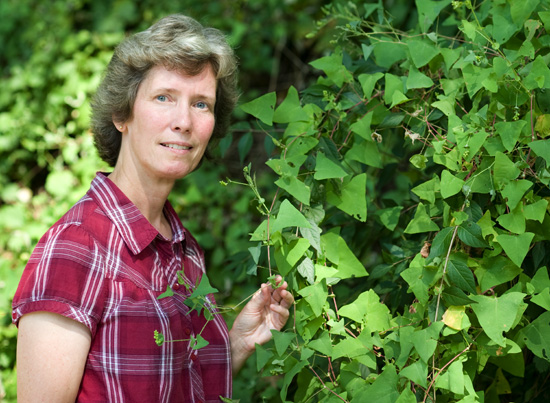 |
| UD entomologist Judy Hugh-Goldstein with her nemesis, mile-a-minute weed (Persicaria perfoliata) picture from:http://www.udel.edu/researchmagazine/issue/vol2_no1_enviro/weevil.html |
The Biological Control of Mile-a-Minute Weed website has a very good description of the "… prickly, branching, annual vine that germinates in early spring, usually in April or May in the mid-Atlantic region." The mile-a-minute weed is an invasive species that no one loves and therefore is a target for control opportunities and eradication efforts when practical. The invasive plant is a vine that can grow up to 18 feet in one season. We are fortunate in some sense that it is an annual, and therefore must reseed itself each year. Growing best in full sun, its iridescent blue berries can survive at least five year creating a seed bank that defies short term control solutions.
Enter the possibilities of biological control and the work of Dr. Judy Hough-Goldstein and her research team as well as their collaborators across the region. Housed at the Dept. Entomology & Wildlife Ecology at the University of Delaware. Biological control is a cost effective as well as very efficient way reducing the impact of invasive species populations. Working with state departments of agriculture and natural resource as well as federal partners such as USDA APHIS, a highly specific insect from the native range of the invasive
mile-a-minute plant has been successfully introduced in the mid Atlantic states and is already munching its way thorough large areas of the nasty, prickly invasive vine.
The exotic Asian weevil, Rhinoncomimus latipes, has established through carefully controlled release programs on mile-a-minute weed. Wherever it has been released it has reduced mile-a-minute cover and biomass. The weevil has also reduced mile-a-minute seed production, and where there are competing plant species a high death rate can occur. It is worth noting that as in gardens, simply removing a pest is not the end of the story, for once mile-a-minute vine or any weed, for that matter, is reduced or eliminated another weed is sure to take its place. Gardeners avoid this by constant maintenance and sophisticated competitive planting schemes. Any control whether biological, chemical or mechanical, therefore is a long term project, not a one time quick fix.
